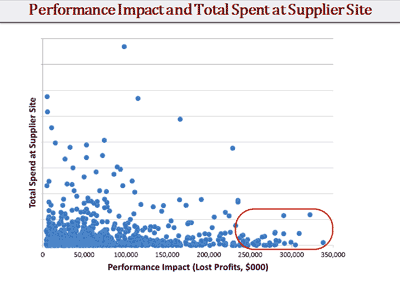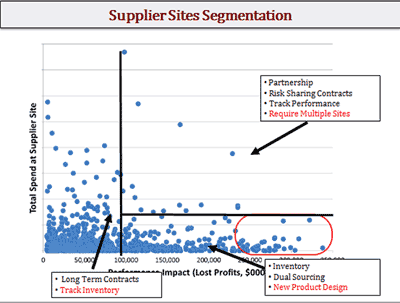 |
April 9, 2015 - Supply Chain Flagship Newsletter |
 |
| FEATURED SPONSOR: JDA |
||
 |
||
Complimentary Webinar Now Available On Demand: S&OP: A Proven Process to Maximize Business Results |
 |
|
||||||||||||||||||||||||||||||||||||||||||||||||||||||||||||||||||||||||||||||||||||||||||
None of this especially scientific. Such an approach certainly doesn't give much guidance about how much to spend in the cause of mitigating any particular risk of a disruption. And it doesn't deal well at all about risks that are impossible to predict, from a tsunami in Asia to a factory fire at a key supplier. In early 2012, Dr. David Simchi-Levi of MIT unveiled his new Risk Exposure Index (REI) for the first time publicly on a Videocast on our Supply Chain Television Channel. This of course was not long after a couple of major supply chain disruptions the previous year: the earthquake and tsunami in Japan and months-long flooding in Thailand. Both those events played major havoc on many automotive and high tech supply chains, and led to one of my favorite supply chain quotes of all-time, when the head of procurement for Toyota and its renowned supply chain stated: "Our assumption that we had a total grip on our supply chain proved to be an illusion." Earlier this week, we produced another Videocast updating major progress with the REI over the last three years, and the award winning success Ford has had with the program. I say award-winning because Simchi-Levi and Ford recently won the prestigious Wagner Award from INFORMS, the leading professional association for operations research and analytics, beating out finalist entries from companies such as Intel and Procter & Gamble. In a touch of irony, on the way to film that broadcast the big news on the car radio in my neck of the woods was that GE's building 6 at its giant appliance factory park in Louisville, KY was burning to the ground. How's that for a supply chain disruption. I cannot do justice to all that was covered in this broadcast in one column, so I am going to try to pick out some highlights. You can now watch the full broadcast one demand here: The Risk Exposure Index 3.0 - the Ford Story. Key to the approach are a couple of concepts. One is time-to-recovery (TTR), which determines how long it would take a node in the supply chain (in-house or of a supplier) to effectively get back full functionality after a major supply chain disruption. So, for example, even if a supplier has another facility, it probably will take at least a couple of weeks to get the added production from an alternative site. In other cases, as Toyota found out, the TTR could be months. Once you understand TTR, you can then calculate the performance impact (PI) from such a disruption, either in hard dollars from lost sales or longer term hits to market share and reputation. Finally, new at least to me on this year's broadcast, we add to that time-to-survive (TTS), which basically measures how long existing inventories would hold out before a disruption would start to impact supply capabilities. So if I haven't lost you yet, when time-to-survive exceeds time-to-recovery at all nodes, you have a very robust supply chain indeed from a risk perspective. Of course, you might respond that this sounds like you get there by just loading up on inventory to increase TTS, sort of anathema generally and especially in a Lean-focused culture at Ford and others in the auto sector. Well, partly yes, if not "loading up" on inventory then at least strategically boosting levels where it makes sense to reduce risk - in an objective way. And importantly, recognize that the same objective (TTS > TTR) can also be achieved by working to reduce time-to-recovery with current inventory levels. Often, it would be some balance. One result of this analysis is shown in the graphic below, which plots performance impact from a disruption at each supply node against the amount Ford spends with each facility. Source: David Simchi-Levi Notice that there is a cluster of sites where the performance impact from a disruption is very large, but Ford's spend is very low. This is a crucial point, and frequently the case, Simchi-Levi says. It is crucial because most companies, including Ford, allocate almost all their supplier risk reduction efforts on suppliers with which they spend a lot of money. These smaller but it turns out big risk suppliers simply were flying under the radar - yet this is where the attention really needed to be, in terms of more precisely quantifying TTR and development of mitigation strategies to reduce that TTR and/or raise TTS. The big dollar risks often lie here, hidden from view. This analysis in turn led a supply chain segmentation strategy, not from a channel/customer perspective as is often the case but from a supplier perspective, again as shown in the graphic below. Source: David Simchi-Levi
At Ford, another interesting result was that this analysis uncovered that in some cases the time-to-survive for certain supplier sites was many months, sometimes almost a year. Simchi-Levi says this created for Ford the opportunity to work with some of these suppliers to reduce inventory levels and share in the resulting supply chain savings. There is a lot more, but I think that's enough for this space. Again, recommend viewing the full videocast. This REI is true supply chain innovation that may lead to a much more systematic approach to supply chain risk management than we have seen to date. Glad we could bring it to you. What do you think of the enhanced Risk Exposure Index? What questions do you have? Let us know your thoughts at the Feedback button or section below. |
|||||||||||||||||||||||||||||||||||||||||||||||||||||||||||||||||||||||||||||||||||||||||||
|
|||||||||||||||||||||||||||||||||||||||||||||||||||||||||||||||||||||||||||||||||||||||||||
|
|||||||||||||||||||||||||||||||||||||||||||||||||||||||||||||||||||||||||||||||||||||||||||
|
|
|
YOUR FEEDBACK
We're frankly backed up on a lot of feedback lately (that's great), but in keeping with the theme this week we're going to jump ahead with a few of the many nice emails we received for our ProMat coverage and videos.
Keep 'em coming!
Feedback on SCDigest ProMat 2015 Coverage and Videos:
Many thanks for your column and the Day 1 and Day 2 videos! It was a busy week and clearly the most successful PROMAT yet. You helped me (and others, I'm sure) to fill in many of the highlights missed in spite of valiant attempts to cover the 800+ exhibits. John M. Hill
|
||
Great work on the full review. I really enjoyed the end of day videos from you and Cliff. It covered a lot that I didn't get to see while I was in our booth. You're a great set of eyes and ears for everyone who didn't get a chance to walk the full show. Thanks. Ryan P. Sheehan
|
||
I agree with your statement regarding automation. There was a significant increase in both the quantity and flexibility of the goods to man technologies. As high quality labor gets harder to find and more expensive is there any other option?
Interesting that you noted that H2 fuel cells had a reduced presence at the show. I saw it the other way. The leader, Plug Power, was in the portion of the show you didn't get to, NMHG is getting into the fuel cell business through Nuvera acquisition and more hydrogen suppliers were there than I've ever seen before. One other interesting new twist was multiple vendors pushing Lithium ion batteries for any size lift truck. I'm not sure they are ready for full scale implementation but this could hold promise if they live up to their claims of significantly longer run times, super fast recharge rates and longer life with almost no maintenance. Could be a tough sell since they are bypassing the lift truck dealers for sales/service but time will tell. Ronn Cypher |
||
Thank you for your outstanding ProMat coverage. Your video summaries are simply a treasure and obviously not replicated by any other publication in the industry. Congratulations to you and Cliff, for being able to identify the key themes and find and well describe the interesting new solutions you found. We want more! David Keller Newport Beach, CA |
||
| Great summary of the show. Sorry I don't have the resources to attend myself.
A question: you mention that RFID solutions were "very hard to find." That is interesting in itself -- your thoughts on why? Regarding RFID, I have been counseled for years that soft goods are a good fit, and hard goods (steel castings, bearings, fasteners, etc.), particularly in a large parts warehouse (think a mining MRO environment) would be a significant challenge. Have you or Cliff seen anything that could change my opinion? You did say that "technology barriers are almost gone." I welcome your feedback. Steven R. Murray
Editor's Note: I just believe that logistic solution companies - notably WMS providers - are not seeing any demand, almost none at all, at least in the US. Somewhat different in Europe and even parts of Asia. Conversely, many of the materials handling companies are moving to vision based systems I think the technology is addressing the issues with metals, but am not real up to speed on that. There is a lot of activity in item level apparel, and as with bar codes think eventually it will move its way back up the supply chain Dan Gilmore
|
SUPPLY CHAIN TRIVIA ANSWER
Q: In what year was the first APICS Certified in Production and Inventory Management (CPIM) designation offered?
A: 1973, even though APICS was formed in 1957.
| © SupplyChainDigest™ 2003-2015. All Rights Reserved. SupplyChainDigest PO Box 714 Springboro, Ohio 45066 |
POWERED BY: XDIMENSION
|











